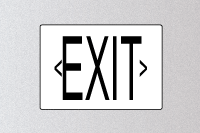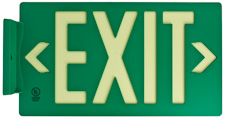When deciding what type of exit signs or emergency lights to purchase, mounting configuration can play a very important role. To those not familiar with mounting configurations, the terminology can be very confusing. The following photos will help you not only to understand what each term means, but will clarify which mounting configuration is best for your installation.
Flush Mount / Wall Mount:
Does not involve the use of mounting canopy. Units typically have knock-out pattern on back plate to mount directly to junction box. (May also allow for “Ceiling Mount” in emergency light fixtures only.)

Ceiling Mount:
Typically requires use of mounting canopy from top of fixture. Some units may further specify Drop Ceiling/New Construction or Sheet Rock/Remodel applications. Use of ceiling mount for exit signage may require double face. (May also allow for “Wall Mount” in emergency light fixtures only.)
Continue reading “Exit Sign Mounting Configurations Explained” »

 While all fire exit signs are required to be illuminated, not all models require electricity. UL 924 listed fire exit signs are available in AC powered, non-electric self luminous Tritium or photoluminescent models all of which are compliant for use in the United States and Canada.
While all fire exit signs are required to be illuminated, not all models require electricity. UL 924 listed fire exit signs are available in AC powered, non-electric self luminous Tritium or photoluminescent models all of which are compliant for use in the United States and Canada.